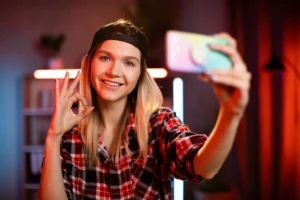Online content consumption has evolved in response to the rise of short-form video. You’re likely watching short videos on YouTube Shorts, Instagram Reels, or TikTok when you browse through your phone during a coffee break or wind down before bed. The social media landscape has undergone significant changes as a result of these platforms’ acquisition of billions of users. Knowing the distinctions between these three titans is more critical than ever if you’re a business trying to reach your audience or a creator unsure of where to focus your efforts.
Who Was the First in the Origin Story?
First on the international scene was TikTok. Initially introduced as Douyin in China in September 2016, it merged with Musical.ly to expand globally in 2018. The app reached one billion users more quickly than Facebook or Instagram did in their early years.
Second was Instagram Reels, which debuted on August 5, 2020. In response to TikTok’s rapid expansion, Meta launched Reels, initially testing it in Brazil in late 2019 before expanding it to more than 50 countries. Given that TikTok may be banned in several markets, the timing was carefully calculated.
Last to arrive was YouTube Shorts, which began its beta rollout in India in September 2020 and expanded globally in 2021. YouTube couldn’t afford to ignore the fact that short-form video was the future of content consumption.
Platform Demographics & Reach
The data presents a convincing picture of who uses each platform and where.
TikTok’s Global Dominance
As of early 2025, TikTok had 1.59 billion monthly active users, ranking fifth globally in terms of social media usage. Although the Asia-Pacific region accounts for more than half of TikTok’s user base (51.17%), the United States leads with 136 million users. Compared to Instagram (35 minutes) or Facebook (30 minutes), users in the US spend an average of 52 minutes a day on the app.
Although younger, the age distribution is expanding. Approximately 55% of TikTok users are between the ages of 18 and 34 each week. Globally, there are 44.3% more female users than male users, with 55.7% of users being male.
The Integrated Benefit of Instagram Reels
Instagram Reels gain from being a part of Instagram’s extensive ecosystem. Nearly all of Instagram’s users, over 2 billion, interact with Reels each month. Every day, over 200 billion reels are viewed on Facebook and Instagram.
With 45.3% of users being female and 54.7% of users being male, the platform exhibits a reasonably balanced gender distribution. The majority of users (31.6%) fall within the 25-34 age range, indicating that Reels appeals to a slightly older audience than TikTok.
The Quick Development of YouTube Shorts
Since its debut, YouTube Shorts has experienced rapid growth. By 2025, the platform is expected to have 2 billion monthly active users and 200 billion daily views. YouTube Shorts has about 164.5 million users in the US alone.
The largest demographic is those aged 25 to 34, who make up 21.5% of all users. There are 42% female viewers and 58% male viewers.
Feature Comparison: The Technical Differences
What creators can make is shaped by the unique tools and features that each platform offers.
Duration and Performance of the Video
Although the sweet spot is still under 60 seconds, TikTok currently permits videos up to 10 minutes for the majority of users. In January 2025, Instagram Reels increased its time limit to three minutes. Although more than 70% of YouTube Shorts are still longer than 15 seconds, the platform’s maximum duration was raised to three minutes in October 2024.
Tools for Editing and Creative Features
Others imitated many of the features that TikTok pioneered. The platform provides text-to-speech, voice effects, green screen capabilities, a wide range of effects, and the ability to stitch or duet videos created by other creators.
Instagram Reels offer strong integration with Instagram’s current features. The well-known filter library on Instagram, the Remix function (comparable to TikTok’s duet), the ability to reuse templates, and seamless sharing to Stories and Feed.
YouTube Shorts keeps things straightforward but effective. YouTube’s vast music library, text overlay and timing controls, speed adjustment tools, analytics integration with YouTube Studio, and multilingual auto-captioning are all available to creators.
How Content Is Seen Through Algorithms and Discovery
Your success depends on your ability to comprehend how each platform determines what to display to users.
How the Algorithms on Each Platform Operate
The accuracy of TikTok’s algorithm is legendary. To provide hyper-personalized content, the For You page analyzes user interactions, video data, and device settings. The speed at which TikTok can display content from accounts with no followers is what sets it apart from other platforms.
Engagement indicators, such as shares, saves, and comments, are given priority in Instagram Reels. Reels still gives preference to accounts with a larger following than TikTok, though, which makes it more difficult for up-and-coming creators to become viral.
YouTube Shorts incorporates Short-specific elements with components from YouTube’s recommendation system. The algorithm values engagement and watch-through rate. Crucially, YouTube links shorts to longer-form content and frequently suggests longer, related videos when a short concludes.
Mechanisms of Discovery
These platforms provide various ways to connect with new audiences:
- The For You page on TikTok controls the user experience by providing an unending supply of content from accounts that users do not follow.
- While the dedicated Reels tab offers continuous access, Instagram’s Explore tab showcases trending Reels.
- YouTube appears in a dedicated feed, and Shorts can also be found in search results and between long-form videos.
With users spending 98 minutes a day worldwide, TikTok excels at creating viral moments. Instagram’s current social graph can be accessed through Instagram Reels. YouTube Shorts can encourage viewers to subscribe to longer-form content and have the advantage of being discoverable through search.

Monetization & Business Opportunities
For creators and companies preparing their content strategy, financial considerations are important.
Revenue Sharing and Creator Funds
Although payouts vary greatly, TikTok offers commissions through the TikTok Shop and the Creator Fund. Reels receive 22% more engagement on Instagram than regular video posts, and the platform rewards creators with bonuses and brand partnerships.
Compared to long-form content, which makes $1.25 to $2.50 per 1,000 views, YouTube Shorts creators now make between $0.01 and $0.07 per 1,000 views. YouTube retains 55% of the revenue, while creators receive 45%.
Brand Partnerships and E-commerce
Though in different ways, brand partnerships are drawn to all three platforms. TikTok is ideal for trend-driven campaigns due to its youthful and active audience. Instagram’s well-known influencer marketplace and shopping tools facilitate easy journeys from discovery to acquisition. YouTube is a powerful tool for product demonstrations because of its credibility.
With the ability to make direct purchases within the app, TikTok Shop has become a significant platform for commerce. Reels and Instagram’s shopping features work well together, as 29% of users buy products on Instagram.
The User Experience: What Distinguishes Every Platform
Each platform develops a unique culture and content style in addition to features and numbers.
TikTok is the most disorganized and trend-driven platform. You can find yourself in highly specialized communities in a matter of hours thanks to its algorithm, which provides you with content that is so tailored to you. Authenticity and humor are valued more on the platform than polish.
Instagram Reels are part of the larger Instagram experience. Instagram’s visual culture is reflected in the content’s tendency toward more polished, aesthetically pleasing presentations. High-quality content on Reels is frequently more successful for brands.
YouTube Shorts is the younger sibling of YouTube. Users who already trust YouTube for entertainment, reviews, and tutorials are drawn to the platform. Shorts are frequently used as previews for longer content. Even in brief formats, the audience expects substance and value.
Choosing the Best Platform for You
Your objectives, target audience, and content style will all influence the response.
When choosing where to concentrate your efforts, take into account these factors:
- TikTok’s algorithm gives up-and-coming creators the best chance at unexpected stardom if you want to maximize your viral potential.
- Reels allow you to efficiently utilize your current audience if you already have an Instagram following.
- YouTube Shorts naturally links to longer, monetizable videos if you produce instructional or tutorial content.
- TikTok Shop offers the most integrated shopping experience for product sellers.
- If you require credibility in the workplace, YouTube holds authority due to its reputation for producing high-quality videos.
The majority of prosperous creators don’t stick to one platform. They keep their primary focus while modifying content for various platforms. Instead of simply duplicating the same video everywhere, the key is to understand the strengths of each platform and the expectations of its audience.
Select a single platform where your target audience is already active. Learn its unique algorithm and style. After you’ve gained traction, carefully branch out to new platforms.
The revolution in short-form video isn’t slowing down. Instagram Reels accounts for 38.5% of all Instagram posts, and TikTok is projected to report $10 billion in US revenue in 2024. Every day, YouTube Shorts receive more than 200 billion views.
Understanding the distinctions between YouTube Shorts, Instagram Reels, and TikTok allows you to allocate your creative energy more effectively. The best option for you will rely on your audience, content type, and particular goals. Every platform offers different opportunities. Regardless of the platform you select, you will succeed if you produce genuine, captivating content that benefits your audience.






